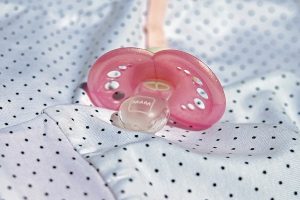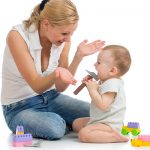
Never has anything lived up to its name quite like the pacifier! It can pacify an upset baby in seconds, and can help the entire family get some much-needed sleep during the early days of sleep deprivation. Still, parents wonder about the drawbacks of pacifier use.
As specialists in speech, language and feeding, we’ve seen that prolonged pacifier use can cause problems with oral motor development, which is crucial for feeding and speech. We’ll take a look at the good, the bad, and how you can use a pacifier wisely to reap its benefits and avoid its downsides.
Highlights:
|
What’s Good About Pacifiers?
Full-term, typical developing babies are born with a strong suckling reflex. In fact, that reflex began in the womb. That’s why you may have seen your baby sucking her thumb in ultrasound pictures. Because babies must suck to eat, this reflex is nature’s way of ensuring that they receive nutrition. Using a pacifier in-between feedings can satisfy your baby’s urge to suck, and it also supports early development of her tongue.
Pacifier use has other upsides as well. It has shown to reduce the risk of SIDS (sudden infant death syndrome) until the age of 6 months, when the risk of SIDS drops. It’s helpful during air travel, because sucking during take-off and landing can reduce ear pressure. Pacifiers can also help babies fall asleep. You may find yourself doing the “pacifier shuffle” as you make your way, half-asleep, to your baby’s crib to reinsert a pacifier. Sometimes this is all it takes to help her (and everyone else in the house) fall back asleep.
Okay, So What’s Bad About Pacifiers?
Research has shown that after 6 months of age, the negatives of pacifier use may begin to outweigh the positives. Prolonged pacifier use has been correlated with an increased risk of ear infections, as well as problems with oral motor development.
For optimal oral motor development, your baby needs to be able to freely move her jaw, tongue and lips. This is especially important during gross motor movement, because gross motor milestones correspond with oral motor milestones. When she is crawling, for instance, the side-to-side movements of her body are also happening inside her mouth. Having a pacifier in her mouth while she is crawling can take away from strengthening those mouth movements, which allow her to bite and chew food, and make more complex speech sounds.
Prolonged pacifier use can also cause problems with proper growth of the mouth and may lead to misaligned teeth, a poorly-shaped roof of the mouth, tongue protrusion, and reduced lip and cheek strength. All of this can interfere with feeding and speech development.
Finally, pacifiers can take away from the benefits of play. Babies naturally use their mouths to explore objects, which helps them understand concepts like shape, temperature, and texture. Play also drives development through meaningful interactions with a caregiver. You will notice that if you play with your baby without a pacifier in her mouth, she will make more sounds and facial expressions.
All of that said, we believe pacifiers have their place. The key is using them wisely by being mindful about how, why, and for how long you use them.
How to Use A Pacifier Wisely
Try other ways to calm your baby first. When she is about 5 months old, her suckling reflex will fade, and that’s a good time to start trying other ways to calm her when she’s upset. Try holding, feeding, rocking, walking, or playing.
Engage in pacifier-free play. As we mentioned above, pacifiers can inhibit the rich learning that happens during play. Take advantage of playtime to encourage your baby to make sounds and facial expressions.
Shelf the pacifier when your baby is moving. Also as mentioned above, allowing your baby to move during tummy time, rolling over, sitting up, crawling, etc. without a pacifier in her mouth will optimize the oral motor development that happens alongside those gross motor milestones.
Give your baby a chance to self-soothe. If she gets upset when she is awake, alert and fed, give her a minute to see if she can calm down on her own. Sometimes a hug, a few reassuring words, or a simple distraction can cut tears short without having to use a pacifier.
Determine whether your baby wants the pacifier or needs it. There will be times during her first year when she simply needs the comfort of a pacifier to feel calm, and that’s okay.
Follow a timeline for taking it away. We recommend that when your baby turns 6 months old, you gradually decrease pacifier use so that when she turns 1 she only uses it for sleeping. Around 18 months, either stop pacifier use altogether or decrease the time she uses it for sleeping so that by her 2nd birthday she is totally pacifier free.
Pacifier use has clear positives and negatives, and we hope this information helps you use them wisely!
Chris Rowlee, M.S., CCC-SLP and Mandy Alvarez, M.S., CCC-SLP of Integrated Children’s Therapy—a Miami-based pediatric speech-language and occupational therapy practice offering individual and group therapy with an emphasis on social communication.
Back







